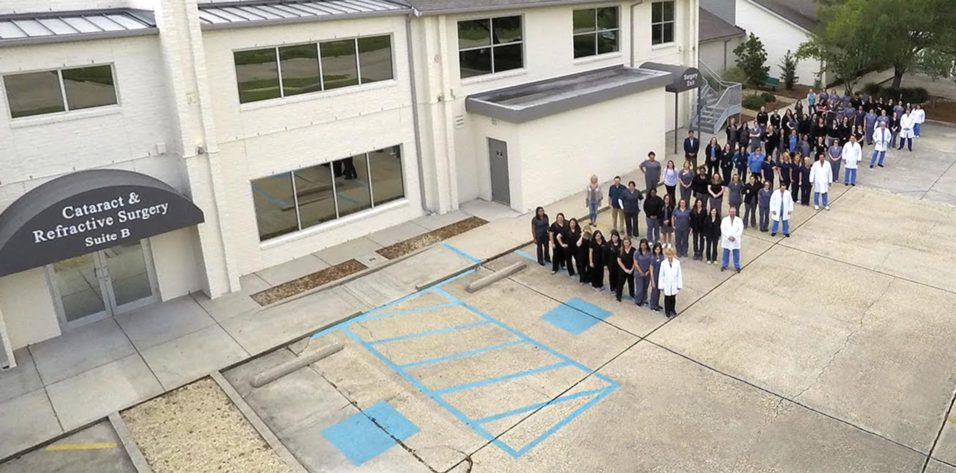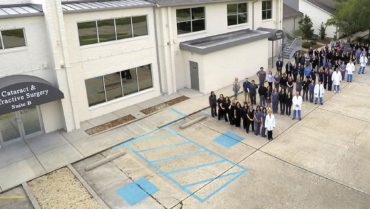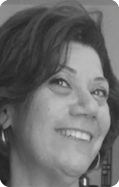
If Williamson Eye Center (WEC) were a novel, it would be a sweeping family saga spanning half a century and three generations. The epic story, set in Baton Rouge, Louisiana, might begin with one of the earliest memories that ophthalmic surgeon Charles Williamson has of his late father, William Williamson, OD, who built the largest private optometric practice in the state in the 1950s and 60s. According to the eye surgeon’s recollection, his dad brought home a plastic cup of cow eyes he had obtained from a local slaughter house for his sons to use with their dissection kit, while he described the anatomy to them. The pioneering optometrist was a champion of the therapeutics bill that expanded the scope of practice for his colleagues in Louisiana and a key figure in the evolution of the profession. Another important memory Dr. Charles Williamson shared was that of his father and Stanley Pearle, OD, the founder of Pearle Vision, standing in the Williamsons’ living room as the two talked about the evolution of eye care. Dr. Pearle became famous for making optometric practices a one-stop shop where patients could get eye care and eyewear. That lesson stuck with Dr. Charles Williamson and later was among the inspirations for the fully integrated WEC.
Encouraged by their father’s commitment to eye care, Dr. Charles Williamson and two of his brothers became ophthalmologists, while their youngest brother became a physician assistant, in the family practice. The four brothers’ ages span more than 20 years, and through 65 years and three generations, the Williamson name has become synonymous with excellence in eye care in Louisiana.
Building an Eye Care Empire
When Dr. Charles Williamson joined his older brother’s practice 40 years ago, they had a central single office but used their father’s five optometric offices as feeder locations for pathology and surgery. Dr. Charles Williamson graduated from the Eye Foundation Hospital, a 105-bed eye surgery hospital located in Birmingham, Alabama, and immediately began planning to build an outpatient surgery center in the practice. Along with his brother William Williamson, MD, who in the 1970s was one of the first surgeons to implant IOLs in the area, Dr. Charles Williamson built the first outpatient surgery center for ophthalmic surgery in Louisiana in 1983; it was one of the first in the nation. After leaving that practice, Dr. Charles Williamson developed the present surgery center in 1987. He became one of the pioneers of outpatient ophthalmic surgery and later developed one of the largest radial keratotomy practices in the state. This naturally led to the practice’s becoming the first LASIK center in Baton Rouge in the early 1990s.
Dr. Charles Williamson is a pioneer of clear corneal cataract surgery and the first to perform that procedure under topical anesthesia. He became one of a handful of surgeons who taught the procedure throughout the world in the early 1990s, earning his place in ophthalmic history books, as that method became the gold standard for ophthalmic cataract surgery today. Traveling nationally and internationally, giving lectures, teaching courses, writing chapters and monographs on refractive and cataract surgery, he was also a part of the first small contingents of surgeons to visit Svyatoslav Fyodorov, MD—developer of the implantable contact lens for the correction of high myopia and hyperopia—in Russia. As one of the early pioneers of that surgery, Dr. Williamson was part of the first FDA study of the Visian ICL (STAAR Surgical).
Although the WEC subsequently developed a large refractive and cataract surgery practice and gained distinction for expertise in that area, it also became a fully integrated, full-service ophthalmic practice, offering primary eye care and eyewear and harkening back to the lesson learned from Dr. Pearle’s eye care integration paradigm. “What started out as a central single office has turned into a large network of offices in the greater Baton Rouge area serving nine parishes in central South Louisiana,” says Dr. Charles Williamson. With four ophthalmologists, six optometrists, and a physician assistant currently involved in the practice, WEC provides a significant amount of primary eye care as well as a large amount of medical ophthalmic care. “With respect to medical eye care, our optometrists are some of the most experienced optometrists in the state,” he adds.
The Challenge of Change
“The evolution of our practice was not easy,” says Dr. Williamson. He points out that some of the challenges to growing the practice are particular to Louisiana’s population and poverty rate. There are only 4.5 million people in the entire state, and approximately 20% are on Medicaid or state assistance; the greater Baton Rouge area itself has only 750,000 people. Dr. Williamson remarks that, although it is not in a large metropolitan market, the WEC has developed into one of the larger state-of-the art premium practices in the country. “When you have a practice like ours that’s an old-line family practice that’s been around for quite a while, it’s dramatically different from a practice forged in the new millennium,” says Dr. Williamson. “The main constant is change and evolution. The ideas, the focus, what we’re doing, and the technology available [are] remarkably different, given the multitude of changes over the last half century.”
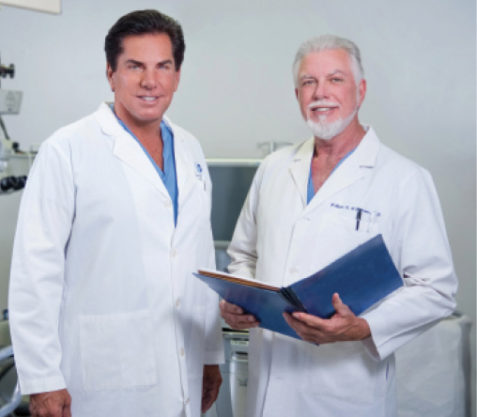
Charles Williamson, MD (left), and his older brother William “Bill” Williamson, MD.
He points out, “I’ve been in practice almost 40 years, and my older brother (William Williamson, MD) almost 44 years. Bill did the first phacoemulsification in the area in the 70s, but 2 years ago, he retired from surgery when my youngest son joined the practice. When we finally decided to acquire the femtosecond laser, [Bill] came out of retirement to perform most of our femtosecond laser surgeries. He’s now the number one femtosecond surgeon in the state of Louisiana. Over 60% of our cataract surgeries are femtosecond laser cataracts. We always change and adapt to lead the way.”
Head for Business
Dr. Charles Williamson’s oldest son, Charles “Chuck” Williamson Jr, directs the business side of the practice and has been a catalyst behind its rapid expansion. “After earning my master’s degree in business and health care, I spent the first year interning here at WEC,” says Chuck Jr. Over the past 15 years, Chuck Jr has served as administrator of the practice, and he has developed optical centers at each of the four locations as well as a separate freestanding lens laboratory.
In addition to its eye care practice, WEC also developed an aesthetic arm, which has grown into the Williamson Cosmetic Center. Eighteen years ago, it was incubated as a separate entity and is now headed by Dr. Charles Williamson’s daughter Shelly Williamson Esnard, PA-C (see Five Facts: Williamson Cosmetic Center below). “The key to any health care enterprise is growth,” says Chuck Williamson Jr. “We have a saying in this business that we must grow or die. Our growth areas in clinics, surgery center, and opticals have increased dramatically over the last 5 years. We’ve improved our business across all these service lines by over 20% in the last year alone. Along with growth, a practice must find a way to develop significant cash-pay procedures and enterprises to withstand the constant pressure of reduced insurance reimbursements. We have done that successfully by growing the opticals’ end of the business, becoming the largest refractive and cataract premium refractive practice in the state, and capitalizing on the emergence and success of our femtosecond [laser] cataract surgery department. These things, along with the development of one of the most successful cosmetic centers in the state, have added substantially to our business portfolio. You can see that our business has a large scope of practice with each part supporting the other. All of this, along with narrowing our surgeons’ focus on the most profitable way to spend their time, has paid huge dividends. It also allows us to develop tremendous expertise in those areas.”
FIVE FACTS: WILLIAMSON COSMETIC CENTER
Almost 20 years ago, Williamson Eye Center’s Charles Williamson, MD, saw the writing on the wall: “From a business standpoint, you have to develop processes that are basically fee for service.” One of the solutions to that demand was the practice’s cosmetic surgery division, which ultimately spun off into a completely separate entity, Williamson Cosmetic Surgery Center (WCSC).
Shelly Williamson Esnard, a physician assistant and injection aficionado, is the managing partner of WCSC. “I’ve learned business the hard way: by doing it,” she says. “I had my dad, Charles Williamson, MD, as a mentor for years. I learned from the ground up and now have been solely responsible for the clinic for the past several years.”
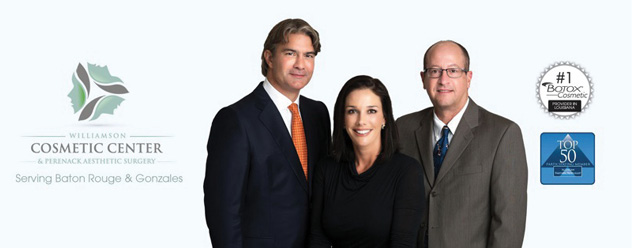
From left: Jon Perenack, MD, DDS, medical director; Shelly Williamson Esnard, PA-C, center director; and Lucius Doucet III, MD.
WCSC is staffed by a board-certified head and neck facial plastic surgeon, a board-certified general body plastic surgeon, and 10 others, including physician assistants, nurse practitioners, and aestheticians. Ms. Esnard says WCSC is rapidly becoming one of the largest plastic surgery centers in Louisiana as well as the state’s number one provider of Botox (Allergan) and dermal fillers. Ms. Esnard is also a national trainer for Allergan Dermatologic and teaches providers across the country how to grow the injectable portion of their practice.
“Marketing is particularly challenging,” she points out, “because there are so many different services offered, so we have had to carefully analyze what works best for various services.” She shares five facts about WCSC.
1. Search engine marketing and optimization ensure that interested patients find us. Our media/marketing plan uses all avenues. We create campaigns for TV, radio, and print. We have found that facial surgery works well on television, because the viewer can see an actual patient, listen to [his or her] experience, and see [the] results. We roll out a new testimonial every year. Our goal is to maintain consistency with the look and sound throughout all types of ads. Body surgery such as breast augmentation is mostly word of mouth; our Internet marketing focuses mainly on search engine marketing and optimization to ensure that, if a potential patient is searching, [he or she] will find us.
2. Use social media. Recently, social media has become an effective resource for us. We use Facebook and Instagram. Our Facebook page tends to be more conservative, while our Instagram page is more casual with lots of videos.
3. Events offer a high return on investment. We offer patient events during the day in the form of a “lunch and learn.” These have proven to have a high return on investment. It is a relaxed environment, and the attendees do not feel pressured to commit to any appointment, which allows them the time to get to know our practice. Our average booking rate from these events is 60%. We also offer evening events twice a year, typically in the form of an open house that includes door prizes, refreshments, and special pricing.
4. Diversification offers protection during downturns. In comparison to traditional plastic surgery practices, our practice is highly diversified with respect to the mix of injectables, Botox, lasers, surgery, etc. This diversification is unique and protective. During natural downturns in surgery, the other procedures can support the practice and vice versa. The mix is surgery 40%, injectables 40%, lasers 15%, [and] retail products 5%.
5. Future focus is on hair restoration and satellite locations. Looking at the future, we will continue to brand the practice as the premier cosmetic surgery center in South Louisiana. We’ll add new service lines as they hit the US market. Hair transplant surgery is something we do very well, and we would like to continue to see that grow. Lastly, the injectable market is continuing to grow, so the consideration of additional satellite locations may be on the horizon.
Generation Next
Although the saga of this practice is steeped in eye care history and has a storied past, it is also enjoying an exciting present and a promising future. Another son, Blake Williamson, MD—a third-generation Williamson—joined the practice in 2015. After finishing residency, he decided to gain more insight into the field of refractive surgery, so he first did a microfellowship with five of the most respected refractive surgeons in Texas in addition to dedicating his first year at WEC toward a refractive and advanced anterior segment fellowship with his father.
Bolstered by an excellent residency at Tulane Medical Center, Dr. Blake Williamson received a Master of Science degree from Columbia University and a Master of Public Health from Johns Hopkins. This education has helped the youngest of the Williamson ophthalmologists continue his father’s legacy in research, medical education, and teaching on a national and international scale.

Charles Williamson, MD (left), and Blake Williamson, MD.
Dr. Blake Williamson has already become very involved with leading the next generation. He is a key opinion leader for multiple surgical device and pharmaceutical companies, and he is active on the editorial boards of ophthalmology trade journals, including MillenialEYE (millennialeye.com), a sister publication of CRST. Recently, Dr. Williamson was honored to be invited to be a member of the ASCRS Council of 100 as well as the chairman for the young refractive surgery initiative within the Refractive Surgery Alliance.
Another integral representative of the younger generation at WEC, according to Dr. Charles Williamson, is Matthew Smith, MD. He joined the practice around 4 years ago and has developed a significant cataract, refractive, and glaucoma following. As one of the two youngest surgeons in the practice—and the only “non-Williamson”—Dr. Smith expects to have an exciting and rewarding future.
Even though Dr. Blake Williamson would seem to have landed in a dream practice, he has worked hard to carve out a niche. He has spearheaded several initiatives, including developing a Center for Excellence for Dry Eye and implanting the first Tecnis Symfony lens (Johnson & Johnson Vision), placing the first Raindrop Near Vision Inlay (ReVision Optics), and performing the first Xen (Allergan) procedure in Louisiana. He was also instrumental in developing the laser cataract surgery suite. “I realize, as the youngest Williamson surgeon here, I’m expected to pick up the mantle of my grandfather, father, and uncles as well as [develop] my role of providing the latest in cutting-edge technology for our patients,” he says.
The two things that separate WEC most from the competition, according to Dr. Blake Williamson, are its surgeons’ experience and skill and the constant adoption of new technology. “The birth of clear corneal cataract surgery under topical anesthesia originated here and evolved into the way modern cataract surgery is performed,” he says. “This was an inspiration for me to make my own mark in our specialty. Our two oldest surgeons have 84 years of combined surgical experience. Surgery is a performance art, and the more you do, the better you become. Our surgeons do more volume than many groups that are four to five times our size. My father told me that volume brings experience and hones your skills. It also brings the chance to be among the first to launch and use new technology. When industry launches a new product, the companies want to put it in the hands of surgeons they trust, people they know will be successful. They also want surgeons whose volume is significant. It’s a real honor that they look to us at WEC, because we have been doing this for decades. I also think our patients appreciate our surgical experience as well as having access to the most cutting-edge technology in our area.”
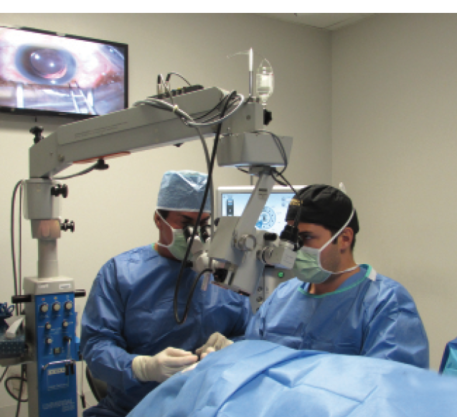
Charles Williamson, MD (left), and Blake Williamson, MD.
Dr. Williamson goes on to say, “I’ve learned to stay on the cutting edge of technology and have launched many new technologies that complement our present expertise. Launching the Dry Eye Center of Excellence was a natural step for this high-volume surgical practice. I saw the opportunity to develop a full-scale dry eye center complete with point-of-care testing, microblepharoexfoliation, thermal meibomian gland pulsation therapy, and amniotic membrane grafting. Our dry eye patients love that we have new options for them, and this is also critical to our success at optimizing the ocular surface prior to refractive and cataract surgery. I’ve also developed an interest and expertise in the new MIGS devices, which are poised to lead the way in the surgical correction of glaucoma. With the high cost burden of medications as well as a high noncompliance rate, glaucoma on the whole has had one of the worst track records for success in our specialty. I believe the MIGS devices will be the path to the future. I have also developed an interest in presbyopia correction and recently added presbyopic inlays to my armamentarium. I expect presbyopia correction will become its own subspecialty within ophthalmology in the future.”
WEC Excellence
The secret to WEC’s excellence transcends high-volume world-class surgeons, cutting-edge procedures, the newest technology, a high-end ambulatory surgery center, teaching initiatives, and a pioneering history. “I really believe what makes our practice truly excellent,” says Dr. Blake Williamson, “is how we treat people—from our teammates [whom] we work with every day, to the patients we take care of together, to our partners in the industry, and the folks who clean up at night. In a large practice like ours, we can’t do it alone, and we have our employees to thank for constantly allowing us to be able to do what we do here at WEC.”
He continues, “I take personal pride in talking to my patients, making sure my focus is entirely upon them so they have the best personal human touch and best experience possible. I believe that type of attitude along with the ability to relate to patients and talk to them about potentially complex surgical procedures, in a way they can understand, is extremely important.”
Dr. Charles Williamson adds, “To obtain excellence, you have to strive to be a master surgeon. To be a master surgeon, experience and surgical skill [are] merely the ante-up chip to sit at the table. Everyone has equal access to technology eventually. You can only elevate to the level of master surgeon through the qualities of personality and judgment. One you are born with, and the other you acquire over time. In any field of endeavor, these are the two most important elements in the pursuit of excellence.”

